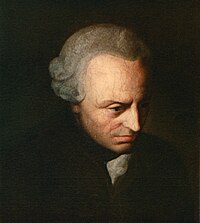Neo-Kantianism
| Part of a series on |
| Immanuel Kant |
|---|
 |
|
Category • |
In
Origins
The "back to Kant" movement began in the 1860s, as a reaction to the
In addition to the work of
Varieties
The several schools of thought, in spite of seeing themselves as united by a common movement, often saw massive fundamental disagreements.[2]
Hermann Cohen became the leader of the Marburg School (centered in the town of the same name), the other prominent representatives of which were Paul Natorp and Ernst Cassirer.
Another important group, the Southwest (German) School (also known as the Heidelberg School or Baden School, centered in
A third group, mainly represented by
The neo-Kantian schools tended to emphasize scientific readings of Kant, often downplaying the role of intuition in favour of concepts. However, the ethical aspects of neo-Kantian thought often drew them within the orbit of socialism, and they had an important influence on Austromarxism and the revisionism of Eduard Bernstein. Lange and Cohen in particular were keen on this connection between Kantian thought and socialism.[4] Another important aspect of the neo-Kantian movement was its attempt to promote a revised notion of Judaism, particularly in Cohen's seminal work, one of the few works of the movement available in English translation.
The neo-Kantian school was of importance in devising a division of philosophy that has had durable influence well beyond Germany. It made early use of terms such as epistemology and upheld its prominence over ontology. Natorp had a decisive influence on the history of phenomenology and is often credited with leading Edmund Husserl to adopt the vocabulary of transcendental idealism. Emil Lask was influenced by Edmund Husserl's work,[5] and himself exerted a remarkable influence on the young Martin Heidegger. The debate between Cassirer and Heidegger over the interpretation of Kant led the latter to formulate reasons for viewing Kant as a forerunner of phenomenology; this view was disputed in important respects by Eugen Fink. An abiding achievement of the neo-Kantians was the founding of the journal Kant-Studien, which still survives today.
By 1933 (after the rise of Nazism), the various neo-Kantian circles in Germany had dispersed.[6]
Further influence
This section needs expansion. You can help by adding to it. (June 2023) |
The Neo-Kantian movement had a significant impact on the development of 20th-century philosophy, particularly in the areas of epistemology, metaphysics, and ethics. It continues to be an important influence on contemporary philosophy, particularly in the fields of social and political philosophy.
Notable neo-Kantian philosophers
- Eduard Zeller (1814–1908)
- Charles Bernard Renouvier(1815–1903)
- Hermann Lotze[7] (1817–1881)
- Hermann von Helmholtz (1821–1894)
- Kuno Fischer (1824–1907)
- Friedrich Albert Lange (1828–1875)
- Wilhelm Dilthey (1833–1911)
- African Spir(1837–1890)
- Otto Liebmann (1840–1912)
- Hermann Cohen (1842–1918)
- Alois Riehl (1844–1924)
- Wilhelm Windelband (1848–1915)
- Johannes Volkelt (1848–1930)
- Benno Erdmann (1851–1921)
- Hans Vaihinger (1852–1933)
- Paul Natorp (1854–1924)
- Émile Meyerson (1859–1933)
- Karl Vorländer (1860–1928)
- Heinrich Rickert (1863–1936)
- Ernst Troeltsch (1865–1923)
- Jonas Cohn (1869–1947)
- Robert Reininger (1869–1955)
- Ernst Cassirer (1874–1945)
- Emil Lask (1875–1915)
- Richard Honigswald(1875–1947)
- Bruno Bauch (1877–1942)
- Leonard Nelson (1882–1927)
- Nicolai Hartmann (1882–1950)
- Hans Kelsen (1881–1973)
- Joseph B. Soloveitchik (1903-1993)
- Related thinkers
- Robert Adamson (1852–1902)
- Henri Poincaré[8] (1854–1912)
- Georg Simmel (1858–1918)
- Max Weber (1864–1920)
- José Ortega y Gasset[9] (1883–1955)
- György Lukács[10] (1885–1971)
- Hermann Weyl[11] (1885–1955)
Contemporary neo-Kantianism
In the
See also
Notes
- ^ Frederick Copleston, A History of Philosophy volume VII (1963), p. 436, states that "at the turn of the [20th] century Neo-Kantianism was the dominant academic philosophy or Schulphilosophie in the German universities". He attributes (p. 361) the "back to Kant" (Zurück zu Kant) slogan to Otto Liebmann, Kant und die Epigonen, 1865.
- ^ Neo-Kantianism - Stanford Encyclopedia of Philosophy, archived from the original on April 15, 2023, retrieved July 2, 2023
- ^ Helmut Pulte (2013), "J. F. Fries' Philosophy of Science, the New Friesian School and the Berlin Group: On Divergent Scientific Philosophies, Difficult Relations and Missed Opportunities", in: N. Milkov & V. Peckhaus (eds.), The Berlin Group and the Philosophy of Logical Empiricism. Springer, pp. 43–66.
- ^ Nguyen, Duy Lap (2022). Walter Benjamin and the Critique of Political Economy. London: Bloomsbury academic. pp. 123–151.
- Barry Smith, “Two Idealisms: Lask and Husserl”, Kant-Studien, 83 (1993), 448–466.
- ^ Luft 2015, p. xxvi.
- ^ Hermann Lotze: Thought: logic and language, Stanford Encyclopedia of Philosophy
- ^ "Poincaré's Philosophy of Mathematics", entry in the Internet Encyclopedia of Philosophy.
- The Stanford Encyclopedia of Philosophy (Summer 2011 Edition), Edward N. Zalta(ed.).
- ^ Georg Lukács: Neo-Kantian Aesthetics, Stanford Encyclopedia of Philosophy
- ^ Hermann Weyl, Stanford Encyclopedia of Philosophy.
- ^ Robert Brandom, A Spirit of Trust: A Reading of Hegel’s Phenomenology, Harvard University Press, 2019.
- ^ Donald Levine (ed.), Simmel: On Individuality and Social Forms, Chicago University Press, 1971, p. xix.
References
- Sebastian Luft (ed.), The Neo-Kantian Reader, Routledge, 2015.
Further reading
- Frederick C. Beiser (2014), The Genesis of Neo-Kantianism, 1796-1880 (Oxford: Oxford University Press)
- Hermann Cohen (1919), Religion of Reason Out of the Sources of Modern Judaism (1978, trans. New York)
- Harry van der Linden (1988), Kantian Ethics and Socialism (Hackett Publishing Company: Indianapolis and Cambridge)
- Thomas Mormann; Mikhail Katz. Infinitesimals as an issue of neo-Kantian philosophy of science. HOPOS: The Journal of the International Society for the History of Philosophy of Science 3 (2013), no. 2, 236–280. See https://www.jstor.org/stable/10.1086/671348 and https://arxiv.org/abs/1304.1027.
- Gillian Rose (1981), Hegel Contra Sociology (Athlone: London)
- Arthur Schopenhauer (1818), The World as Will and Representation (1969, trans. Dover: New York)
- Homburg Phillip. Walter Benjamin and the Post-Kantian Tradition. Rowman & Littlefield International 2018.
External links
 Quotations related to Neo-Kantianism at Wikiquote
Quotations related to Neo-Kantianism at Wikiquote- Neo-Kantianism article in the Internet Encyclopedia of Philosophy
